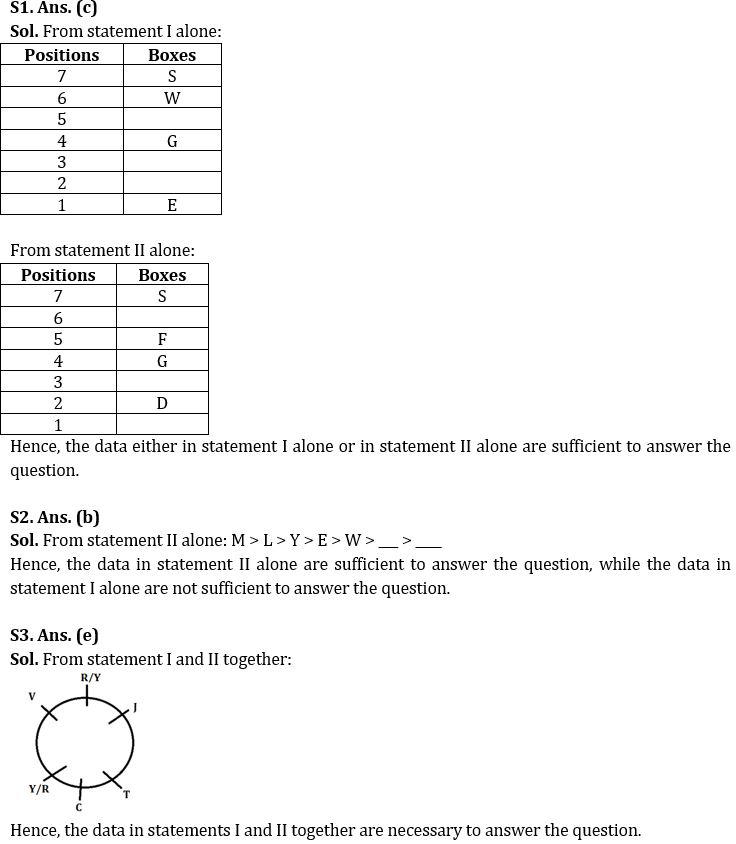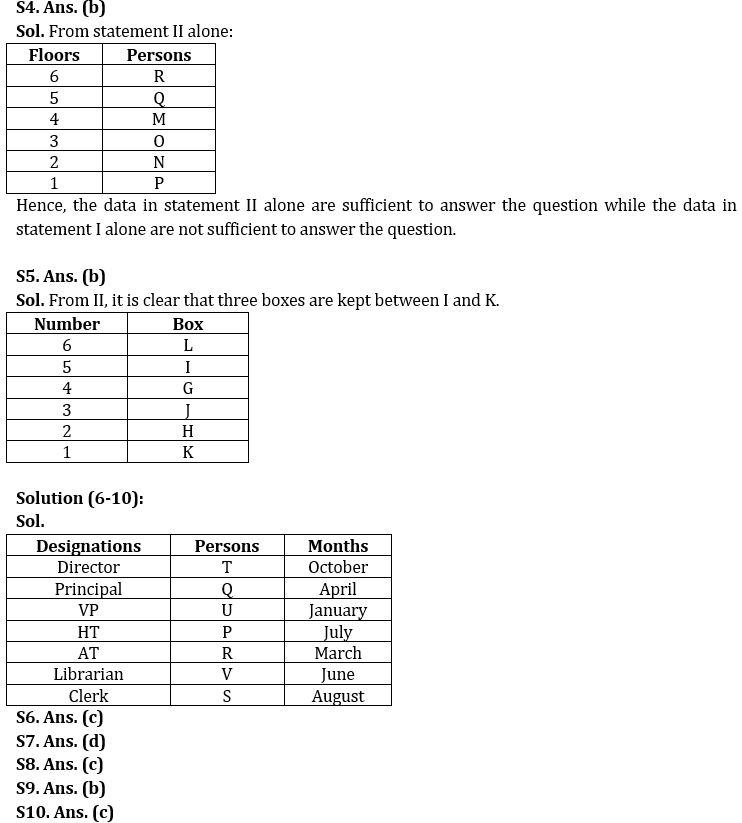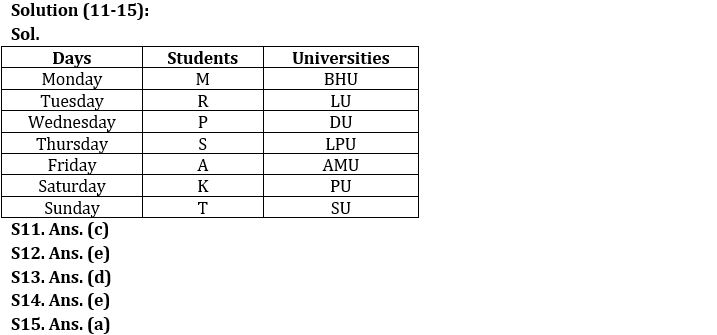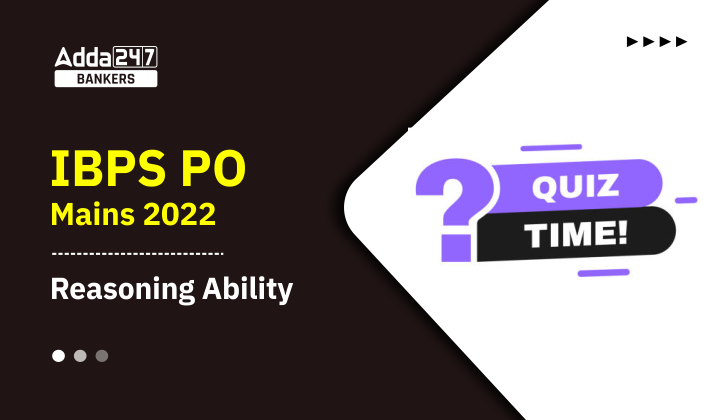Direction (1-5): The question given below consists of two statements numbered I and II given below it. You have to decide whether the data provided in the statements are sufficient to answer the question. Read all the statements and give answer.
Q1. Seven boxes i.e., W, E, R, S, D, F, and G are placed one above other. Which of the following box is placed at fourth position from top?
Statements:
I. Two boxes are placed between G and E. One box is placed between G and W in which W is placed above G. S is placed above G but not just above. More than three boxes are placed between E and S.
II. F is placed just above G. Two boxes are placed between F and D. One box is placed below D. Two boxes are placed between G and S but S does not place below D.
(a) The data in statement I alone are sufficient to answer the question, while the data in statement II alone are not sufficient to answer the question.
(b) The data in statement II alone are sufficient to answer the question, while the data in statement I alone are not sufficient to answer the question.
(c) The data either in statement I alone or in statement II alone are sufficient to answer the question.
(d) The data given in statements I and II together are not sufficient to answer the question.
(e) The data in statements I and II together are necessary to answer the question.
Q2. Who among the following is the second fastest?
Statements:
I. In seven friends, G is faster than U and slower than T. H is not as fast as F. F is slower than U.
II. In seven friends, E is faster than W and slower than Y. Two friends are slower than W. M is not as slow as L. Y is not as fast as L.
(a) The data in statement I alone are sufficient to answer the question, while the data in statement II alone are not sufficient to answer the question.
(b) The data in statement II alone are sufficient to answer the question, while the data in statement I alone are not sufficient to answer the question.
(c) The data either in statement I alone or in statement II alone are sufficient to answer the question.
(d) The data given in statements I and II together are not sufficient to answer the question.
(e) The data in statements I and II together are necessary to answer the question.
Q3. Six friends i.e., C, V, J, Y, T and R have seated around a circular table and facing towards center. Who among the following sits to the immediate left of J?
Statements:
I. One friend sits between C and V. Two friends sit between V and T. Not more than one person sits between T and J (from either side). J does not sit near to V.
II. One person sits between R and T. V sits second to the left of C. T sits to the immediate right of C.
(a) The data in statement I alone are sufficient to answer the question, while the data in statement II alone are not sufficient to answer the question.
(b) The data in statement II alone are sufficient to answer the question, while the data in statement I alone are not sufficient to answer the question.
(c) The data either in statement I alone or in statement II alone are sufficient to answer the question.
(d) The data given in statements I and II together are not sufficient to answer the question.
(e) The data in statements I and II together are necessary to answer the question.
Q4. The persons M, N, O, P, Q and R live on different floor of a six-storey building in which the bottommost floor is numbered as 1 and topmost floor is numbered as 6. Who lives on third floor?
Statements:
I. Two persons live above M. O lives immediately above N. Two persons live between M and P.
II. R lives three floors above O. One person lives between O and P. M lives two floors above N who lives adjacent to P.
(a) The data in statement I alone are sufficient to answer the question, while the data in statement II alone are not sufficient to answer the question.
(b) The data in statement II alone are sufficient to answer the question, while the data in statement I alone are not sufficient to answer the question.
(c) The data either in statement I alone or in statement II alone are sufficient to answer the question.
(d) The data given in statements I and II together are not sufficient to answer the question.
(e) The data in statements I and II together are necessary to answer the question.
Q5. Six boxes (G, H, I, J, K, and L) are kept one above the other, such that the bottommost box is numbered as 1, the box above it as 2 and so on. How many boxes are kept between I and K?
Statements:
I. L is two boxes above G. K is below G. J is two boxes above K. K is not an even numbered box. I is kept above H which not the bottommost box.
II. H is kept immediately below J. Three boxes are kept between H and L. H is an even numbered box. I is kept above K. G is not prime numbered box. K is not an even numbered box.
(a) The data in statement I alone are sufficient to answer the question, while the data in statement II alone are not sufficient to answer the question.
(b) The data in statement II alone are sufficient to answer the question, while the data in statement I alone are not sufficient to answer the question.
(c) The data either in statement I alone or in statement II alone are sufficient to answer the question.
(d) The data given in statements I and II together are not sufficient to answer the question.
(e) The data in statements I and II together are necessary to answer the question.
Directions (6-10): Answer the questions based on the information given below:
Seven persons P, Q, R, S, T, U and V work in a school on different designations. The designations are Clerk, Librarian, Assistant Teacher (AT), Head Teacher (HT), Vice Principal (VP), Principal and Director such that Clerk is the junior most designation whereas Director is the senior most designation. Each of them takes leave on 4th of different months (January, March, April, June, July, August and October) of the same year.
S is two designations junior to R. V doesn’t take leave in July. R takes leave five months before S. S is neither Vice Principal nor Assistant Teacher. V is senior to only one person who takes leave in August. Person who takes leave in July, is three designations junior to the one who takes leave in October. U takes leave before Q who takes leave before V. Designation of Q is junior to only one person. Designation of T is senior to that of P but not immediate senior. P takes leave after 3rd June.
Q6. How many persons take leave before the person whose designation is Librarian?
(a) One
(b) Two
(c) Three
(d) Four
(e) None of these
Q7. Four from the following are similar in a certain way and forms a group. Find out the one which does not belong to that group.
(a) T – October – Director
(b) U – January – Vice Principal
(c) V – June – Librarian
(d) Q – January – Principal
(e) S – August – Clerk
Q8. Who takes leave in the January month?
(a) Q
(b) P
(c) U
(d) V
(e) None of these
Q9. What is the designation of S?
(a) Librarian
(b) Clerk
(c) HT
(d) AT
(e) None of these
Q10. V takes leave in which of the following month?
(a) July
(b) January
(c) June
(d) August
(e) None of these
Directions (11-15): Answer the questions based on the information given below.
Seven students namely, M, P, A, T, K, S and R, study in seven different universities among, LU, LPU, BHU, DU, SU, PU and AMU but not necessarily in the same order. Each of them went to their respective home on seven different days of a week starting from Monday.
P who studies in DU went two days before the student who studies in AMU. K went to his home two days after S. T who studies in SU went immediately after K. At most two students went after the student who studies in SU. The one who studies in DU went before S. The one who studies in LU went immediately after the student who studies in BHU. R went after the student who studies in BHU. The one who studies in PU went after the person who studies in LPU. A who went after M, doesn’t study in LU. A doesn’t study in BHU. M doesn’t go immediately before A.
Q11. The student who went immediately after A, studies in which of the following university?
(a) LU
(b) BHU
(c) PU
(d) SU
(e) None of these
Q12. How many persons went after the person who went immediately after M?
(a) One
(b) Two
(c) Three
(d) Four
(e) None of these
Q13. Who among the following studies in BHU?
(a) A
(b) R
(c) S
(d) M
(e) None of these
Q14. Four from the following are similar in a certain way and forms a group. Find out the one which does not belong to that group.
(a) T – PU
(b) K – AMU
(c) S – DU
(d) R – BHU
(e) M -LPU
Q15. Who among the following studies in AMU?
(a) A
(b) P
(c) S
(d) K
(e) None of these
Solutions








 50+ Data Sufficiency Questions For Bank ...
50+ Data Sufficiency Questions For Bank ...
 Quantitative Aptitude Quiz For Bank Main...
Quantitative Aptitude Quiz For Bank Main...





